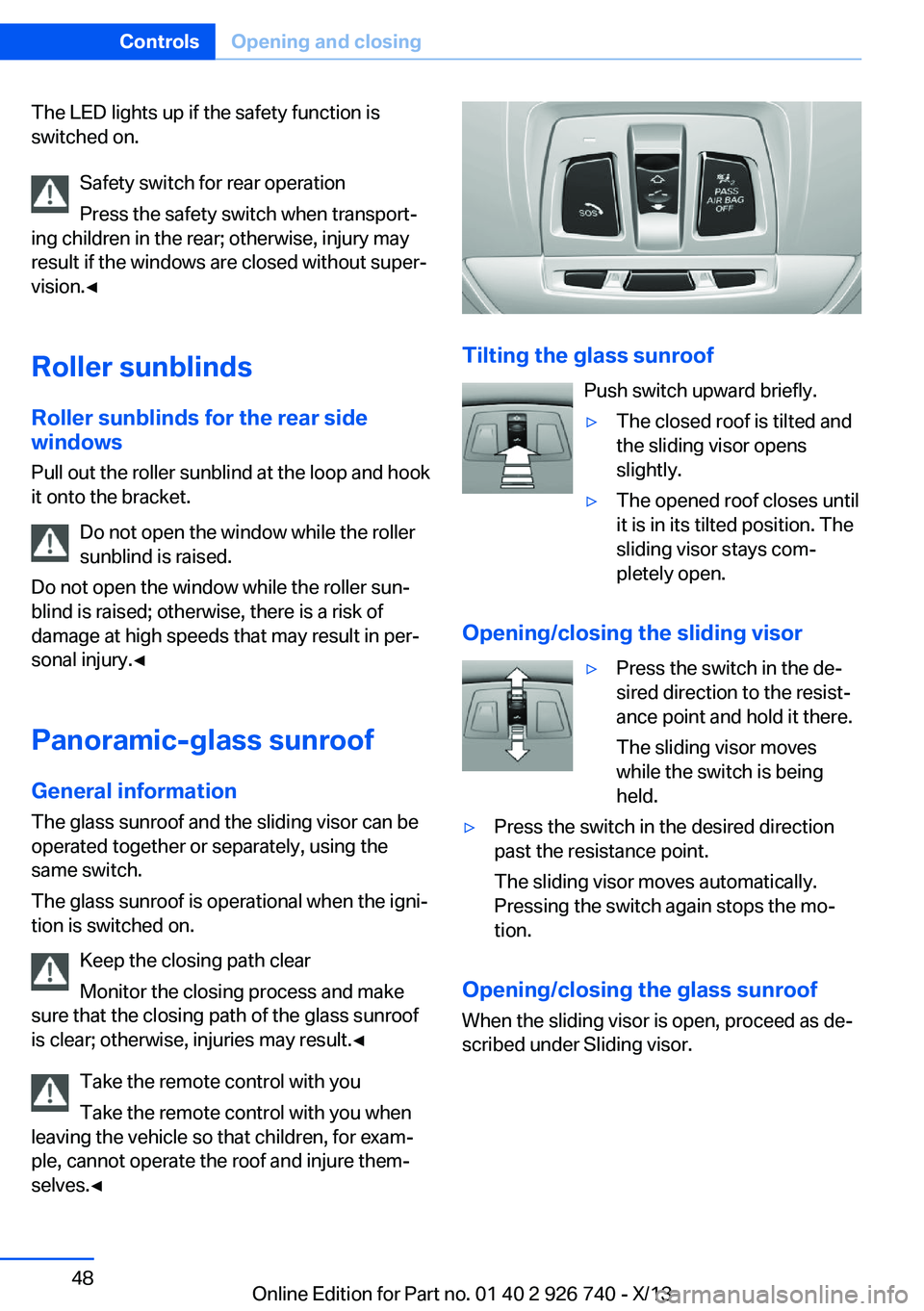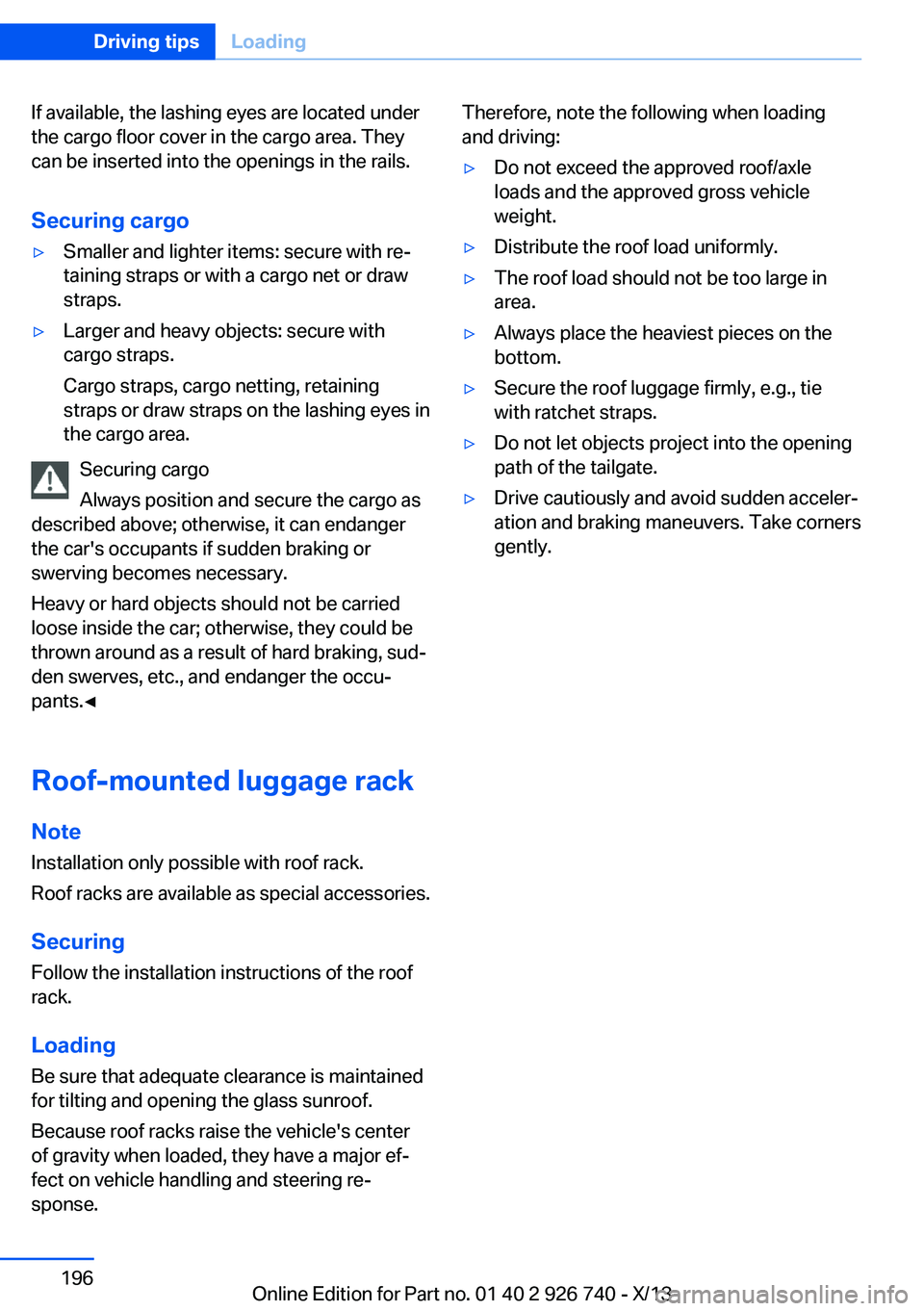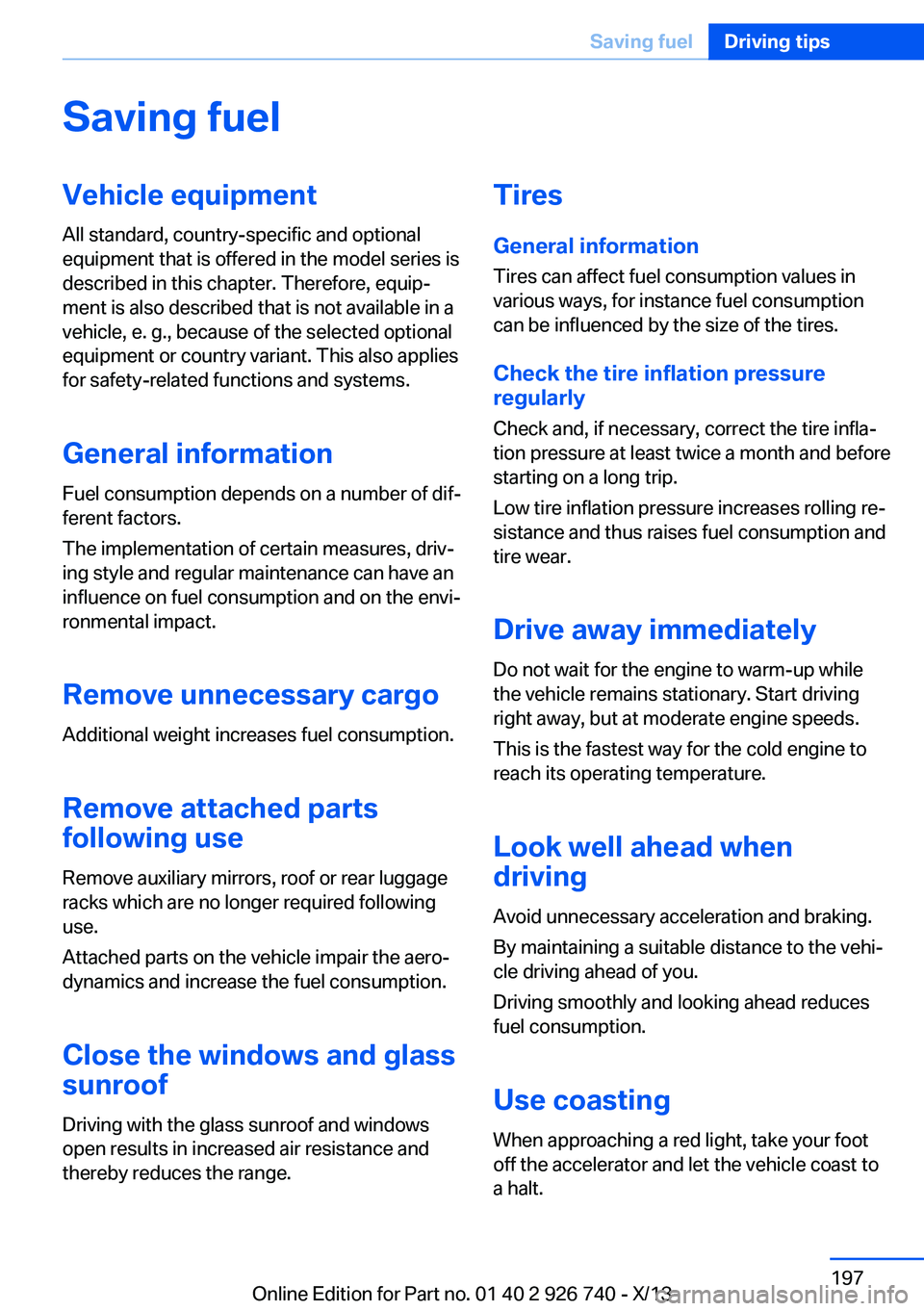2014 BMW X5 XDRIVE 50I roof rack
[x] Cancel search: roof rackPage 48 of 265

The LED lights up if the safety function is
switched on.
Safety switch for rear operation
Press the safety switch when transport‐
ing children in the rear; otherwise, injury may
result if the windows are closed without super‐
vision.◀
Roller sunblinds
Roller sunblinds for the rear side
windows
Pull out the roller sunblind at the loop and hook
it onto the bracket.
Do not open the window while the rollersunblind is raised.
Do not open the window while the roller sun‐
blind is raised; otherwise, there is a risk of
damage at high speeds that may result in per‐
sonal injury.◀
Panoramic-glass sunroof General information
The glass sunroof and the sliding visor can be
operated together or separately, using the
same switch.
The glass sunroof is operational when the igni‐
tion is switched on.
Keep the closing path clear
Monitor the closing process and make
sure that the closing path of the glass sunroof
is clear; otherwise, injuries may result.◀
Take the remote control with you
Take the remote control with you when
leaving the vehicle so that children, for exam‐
ple, cannot operate the roof and injure them‐
selves.◀
Tilting the glass sunroof
Push switch upward briefly.
▷The closed roof is tilted and
the sliding visor opens
slightly.▷The opened roof closes until
it is in its tilted position. The
sliding visor stays com‐
pletely open.
Opening/closing the sliding visor
▷Press the switch in the de‐
sired direction to the resist‐
ance point and hold it there.
The sliding visor moves
while the switch is being
held.▷Press the switch in the desired direction
past the resistance point.
The sliding visor moves automatically.
Pressing the switch again stops the mo‐
tion.
Opening/closing the glass sunroof
When the sliding visor is open, proceed as de‐
scribed under Sliding visor.
Seite 48ControlsOpening and closing48
Online Edition for Part no. 01 40 2 926 740 - X/13
Page 196 of 265

If available, the lashing eyes are located under
the cargo floor cover in the cargo area. They
can be inserted into the openings in the rails.
Securing cargo▷Smaller and lighter items: secure with re‐
taining straps or with a cargo net or draw
straps.▷Larger and heavy objects: secure with
cargo straps.
Cargo straps, cargo netting, retaining
straps or draw straps on the lashing eyes in
the cargo area.
Securing cargo
Always position and secure the cargo as
described above; otherwise, it can endanger
the car's occupants if sudden braking or
swerving becomes necessary.
Heavy or hard objects should not be carried
loose inside the car; otherwise, they could be
thrown around as a result of hard braking, sud‐
den swerves, etc., and endanger the occu‐
pants.◀
Roof-mounted luggage rack
Note Installation only possible with roof rack.
Roof racks are available as special accessories.
Securing
Follow the installation instructions of the roof
rack.
Loading Be sure that adequate clearance is maintained
for tilting and opening the glass sunroof.
Because roof racks raise the vehicle's center
of gravity when loaded, they have a major ef‐
fect on vehicle handling and steering re‐
sponse.
Therefore, note the following when loading
and driving:▷Do not exceed the approved roof/axle
loads and the approved gross vehicle
weight.▷Distribute the roof load uniformly.▷The roof load should not be too large in
area.▷Always place the heaviest pieces on the
bottom.▷Secure the roof luggage firmly, e.g., tie
with ratchet straps.▷Do not let objects project into the opening
path of the tailgate.▷Drive cautiously and avoid sudden acceler‐
ation and braking maneuvers. Take corners
gently.Seite 196Driving tipsLoading196
Online Edition for Part no. 01 40 2 926 740 - X/13
Page 197 of 265

Saving fuelVehicle equipmentAll standard, country-specific and optional
equipment that is offered in the model series is
described in this chapter. Therefore, equip‐
ment is also described that is not available in a
vehicle, e. g., because of the selected optional
equipment or country variant. This also applies
for safety-related functions and systems.
General information Fuel consumption depends on a number of dif‐
ferent factors.
The implementation of certain measures, driv‐
ing style and regular maintenance can have an
influence on fuel consumption and on the envi‐
ronmental impact.
Remove unnecessary cargoAdditional weight increases fuel consumption.
Remove attached parts
following use
Remove auxiliary mirrors, roof or rear luggage
racks which are no longer required following
use.
Attached parts on the vehicle impair the aero‐
dynamics and increase the fuel consumption.
Close the windows and glass
sunroof
Driving with the glass sunroof and windows
open results in increased air resistance and
thereby reduces the range.Tires
General information
Tires can affect fuel consumption values in
various ways, for instance fuel consumption
can be influenced by the size of the tires.
Check the tire inflation pressure
regularly
Check and, if necessary, correct the tire infla‐
tion pressure at least twice a month and before
starting on a long trip.
Low tire inflation pressure increases rolling re‐
sistance and thus raises fuel consumption and
tire wear.
Drive away immediately
Do not wait for the engine to warm-up while
the vehicle remains stationary. Start driving
right away, but at moderate engine speeds.
This is the fastest way for the cold engine to
reach its operating temperature.
Look well ahead when
driving
Avoid unnecessary acceleration and braking.
By maintaining a suitable distance to the vehi‐
cle driving ahead of you.
Driving smoothly and looking ahead reduces
fuel consumption.
Use coasting
When approaching a red light, take your foot
off the accelerator and let the vehicle coast to
a halt.Seite 197Saving fuelDriving tips197
Online Edition for Part no. 01 40 2 926 740 - X/13
Page 259 of 265

Locking/unlocking from in‐side 40
Locking/unlocking via door lock 39
Locking/unlocking with re‐ mote control 38
Locking, automatic 44
Locking, central 37
Locking, settings 44
Lock, power window 47
Locks, doors, and win‐ dows 66
Low beams 99
Low beams, automatic, refer to High-beam Assistant 101
Lower back support 52
Lower tailgate 43
Low-Sulfur Diesel 207
Luggage rack, refer to Roof- mounted luggage rack 196
Lumbar support 52
M
Maintenance 229
Maintenance require‐ ments 229
Maintenance, service require‐ ments 90
Maintenance system, BMW 229
Malfunction displays, refer to Check Control 86
Malfunction, self-leveling sus‐ pension 135
Manual air distribution 166
Manual air flow 166
Manual brake, refer to Parking brake 71
Manual mode, transmis‐ sion 79
Manual operation, backup camera 154
Manual operation, door lock 40 Manual operation, exterior
mirrors 60
Manual operation, fuel filler flap 204
Manual operation, Park Dis‐ tance Control PDC 151
Manual operation, parking brake 73
Manual operation, Top View 157
Marking on approved tires 219
Marking, run-flat tires 220
Master key, refer to Remote control 34
Maximum cooling 167
Maximum speed, display 91
Maximum speed, winter tires 220
Measure, units of 96
Medical kit 240
Memory for seat, mirrors, steering wheel 59
Menu, EfficientDynamics 200
Menu in instrument clus‐ ter 93
Menus, operating, iDrive 18
Menus, refer to iDrive operat‐ ing concept 20
Messages, refer to Check Control 86
Microfilter 168
Minimum tread, tires 218
Mirror 60
Mirror memory 59
Mobile communication devi‐ ces in the vehicle 191
Modifications, technical, refer to Safety 7
Moisture in headlamp 233
Monitor, refer to Control Dis‐ play 18
Mounting of child restraint fix‐ ing systems 63
Moving sun shade 181 Multifunction steering wheel,
buttons 14
N
Navigation, see user's manual for Navigation, Entertain‐
ment and Communication
Neck restraints, front, refer to Head restraints 57
Neck restraints, rear, refer to Head restraints 58
Neutral cleaner, see wheel cleaner 246
New wheels and tires 218
Night Vision with pedestrian detection 121
No Passing Information 91
Nylon rope for tow-starting/ towing 243
O OBD Onboard Diagnosis 229
OBD, see OBD Onboard Di‐ agnosis 229
Obstacle marking, rearview camera 155
Octane rating, refer to Gaso‐ line quality 206
Odometer 89
Office, see user's manual for Navigation, Entertainment
and Communication
Offroad trips 193
Oil 224
Oil, adding 225
Oil additives 225
Oil change 226
Oil change interval, service requirements 90
Oil filler neck 225
Oil types, alternative 226
Oil types, approved 225
Old batteries, disposal 238 Seite 259Everything from A to ZReference259
Online Edition for Part no. 01 40 2 926 740 - X/13
Page 260 of 265

Onboard monitor, refer toControl Display 18
Onboard vehicle tool kit 231
Opening and closing 34
Opening and closing, from in‐ side 40
Opening and closing via door lock 39
Opening and closing, with re‐ mote control 38
Operating concept, iDrive 18
Optional equipment, standard equipment 6
Outside air, refer to Auto‐ matic recirculated-air con‐
trol 167
Overheating of engine, refer to Coolant temperature 89
P Paint, vehicle 245
Panorama Side View 158
Panoramic glass sunroof 48
Parallel parking assistant 159
Park Distance Control PDC 150
Parked-car heating 171
Parked-car ventilation 171
Parked vehicle, condensa‐ tion 192
Parking aid, refer to PDC 150
Parking assistant 159
Parking brake 71
Parking lamps 99
Parking with Auto Hold 72
Particulate filter 191
Passenger side mirror, tilting downward 60
Pathway lines, rearview cam‐ era 154
PDC Park Distance Con‐ trol 150
Pedestrian detection, refer to Night Vision 121 Pedestrian warning with city
braking function 119
People detection, refer to Night Vision 121
Personal Profile 35
Pinch protection system, glass sunroof 49
Pinch protection system, win‐ dows 47
Plastic, care 246
Power failure 238
Power windows 46
Pressure, tire air pres‐ sure 211
Pressure warning FTM, tires 110
Preventing Auto Start Stop 70
Profile, refer to Personal Pro‐ file 35
Programmable memory but‐ tons, iDrive 24
Protective function, glass sunroof 49
Protective function, win‐ dows 47
Push-and-turn switch, refer to Controller 18, 19
Q Queuing Assistant, see Con‐ gestion Assistant 145
R Radiator fluid 227
Radio-operated key, refer to Remote control 34
Radio ready state 67
Radio, see user's manual for Navigation, Entertainment
and Communication
Rain sensor 75
Rear automatic climate con‐ trol 169 Rear center armrest 184
Rear drink holder 185
Rear lamps 235
Rear socket 179
Rear ventilation, third row of seats, ventilation, third row
of seats 169
Rearview mirror 60
Rear window defroster 167
Recirculated-air mode 167
Recommended tire brands 219
Refueling 204
Remaining range 89
Remote control/key 34
Remote control, malfunc‐ tion 39
Remote control, parked-car heating/ventilation 172
Remote control, univer‐ sal 175
Replacement fuse 238
Replacing parts 231
Replacing wheels/tires 218
Reporting safety defects 9
RES button 141
Reserve warning, refer to Range 89
Reset, Tire Pressure Monitor TPM 108
Residual heat, automatic cli‐ mate control 167
Retaining straps, securing cargo 195
Retreaded tires 219
Roadside parking lamps 100
Roller sunblinds 48
RON gasoline quality 206
Roof load capacity 250
Roof-mounted luggage rack 196
Rope for tow-starting/ towing 243
RSC Run Flat System Com‐ ponent, refer to Run-flat
tires 220 Seite 260ReferenceEverything from A to Z260
Online Edition for Part no. 01 40 2 926 740 - X/13